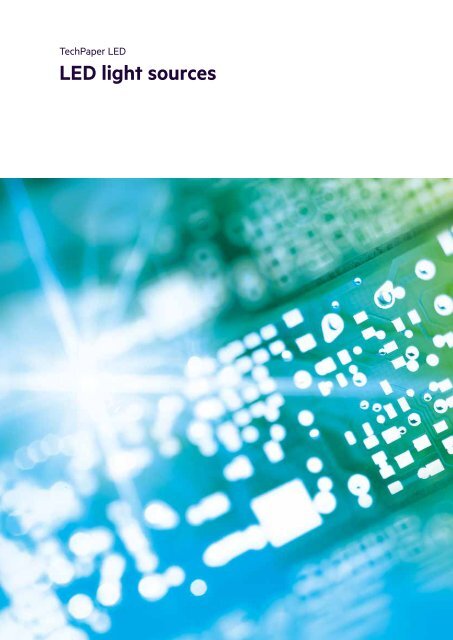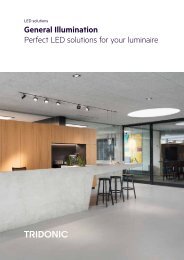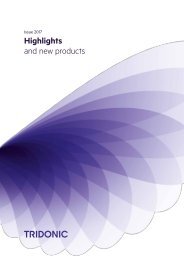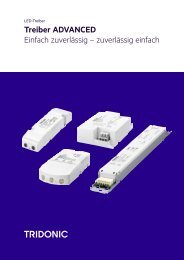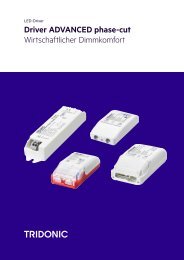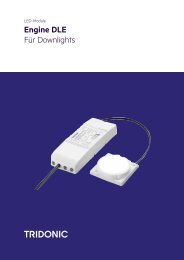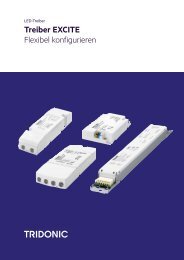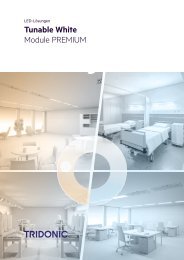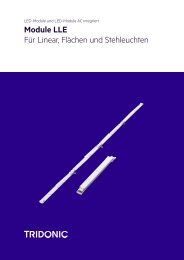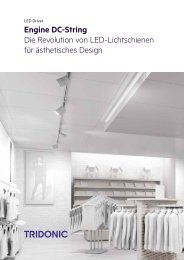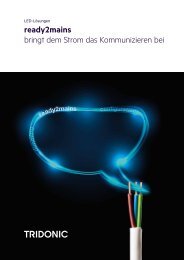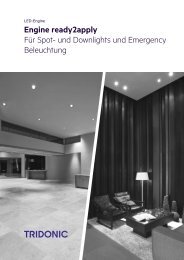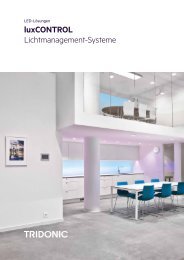You also want an ePaper? Increase the reach of your titles
YUMPU automatically turns print PDFs into web optimized ePapers that Google loves.
<strong>TechPaper</strong> LED<br />
LED light sources
<strong>TechPaper</strong><br />
The light of the future<br />
LED technology<br />
Light emitting diodes (LED) are the shooting stars of the lighting<br />
scene: Tiny and extremely efficient, they are revolutionising the<br />
world of light at the start of the 21st century. They are providing<br />
new levels of lighting quality in more and more new applications.<br />
LEDs started out as coloured signal lamps but they soon outgrew this<br />
initial application. Today the LED is synonymous with the future of<br />
light and is superior in so many ways to other options. LEDs can be<br />
used in so many varied application and its versatility and variety of<br />
shapes and colours are truly impressive.<br />
LEDs provide the basis for lighting solutions that exceeds anything<br />
that has gone before. Thanks to their small size, enormous range of<br />
colours and digital dimmability they are opening up completely new<br />
applications and design opportunities. Their efficiency, durability and<br />
lack of maintenance are also helping to make LEDs the light sources<br />
of the future. The list of the positive features of LEDs is endless.
The most important benefits are as follows:<br />
——<br />
Instant flicker-free light<br />
——<br />
Very low direct thermal output<br />
——<br />
No IR or UV radiation in the light<br />
——<br />
Constant colour throughout the life of the LED<br />
——<br />
Very high luminous efficacy<br />
——<br />
Insensitive to vibrations<br />
——<br />
Easy disposal at end of life<br />
A big reputation<br />
Tridonic stands for supreme quality. 60 years of experience and<br />
success in the lighting industry speaks for itself. Since 1991, the<br />
company has been working intensively with LED technology in all its<br />
aspects – from complete LED system solutions, to LED modules and<br />
LED drivers. There are 130 LED experts working for Tridonic in the<br />
Technology and Research Centre in Jennersdorf alone and they are<br />
setting new standards.<br />
In addition to its in-house research and development facilities,<br />
Tridonic has entered cooperative agreements and partnerships with<br />
renowned companies and research institutions such as LG Innotek, a<br />
subsidiary of the Korean LG Group, the Technical University of Vienna,<br />
the Fraunhofer Institute in Dresden, ETH Zurich and the University of<br />
Newcastle, to name but a few.<br />
Key technological expertise at Tridonic is being strategically<br />
strengthened not only by these cooperation agreements and partnerships<br />
but also by significant investment in development, production,<br />
marketing and sales.<br />
Phosphor of high quality<br />
Tridonic uses state of the art phosphors with the highest quantum<br />
efficiency availbale on the market. All phosphors are qualified in our<br />
own testing-environment. We have the expertise to offer optimised<br />
phosphor composition for the customers need therefore we offer LED<br />
modules with different light temperatures and excellent colour renderings<br />
with high efficacy. In addition we also offer special light colours<br />
and optimised spectral tuning, e.g. for fashion or art.<br />
——<br />
Patent families since 2008: total 453, 75 % LED related<br />
——<br />
52 % of turnover with new products (
<strong>TechPaper</strong><br />
Differences – LED layouts<br />
Chip on board (COB) versus Surface mounted device (SMD)<br />
There are two main techniques for mounting LEDs to the surface<br />
of a printed circuit board. Chip on board technology means the<br />
different components of the LED (chip, fluorescent converter,<br />
wire bond) are built together on the printed circuit board. SMD<br />
technology means the different components of the LED are prefabricated.<br />
The unit is soldered to the printed circuit board as a<br />
whole.<br />
Board Pad<br />
Bond wire (Al, Au)<br />
Chip Pad<br />
LED (blue)<br />
Phosphor fill up<br />
Dam<br />
Thermal glue<br />
PCB<br />
The decision as to which of the two technologies is used mainly depends<br />
on the proposed application. Typically SMD is more often used<br />
for area modules whereas COB is used for spot modules.<br />
SMD Housing<br />
Phosphor fill up<br />
Reflector<br />
Bond wire<br />
LED (blue)<br />
Thermal glue<br />
SMD connectors<br />
Thermal Resitor<br />
PCB<br />
Chip on board technology (COB)<br />
In the case of chip on board technology, “naked” unpackaged semiconductor<br />
chips, known as “dies”, are attached directly to the circuit<br />
board by means of an adhesive with high thermal conductivity and<br />
connected to the pads on the circuit board via “wire bonding”. Gold<br />
wires with cross sections in the micrometre range are used for making<br />
electrical contact. The open parts are covered with a potting compound<br />
to protect them from mechanical exposure and pollution. For<br />
this, the so-called dam and fill technique is used. First, a dam is drawn<br />
around the components with a viscous fluid. Subsequently, the intermediate<br />
space is filled with a liquid, which hardens afterwards.<br />
Surface mounted device technology (SMD)<br />
SMD LEDs are designed for automatic population of circuit boards<br />
and extremely low-profile and narrow modules. Encapsulated SMD<br />
LEDs are fixed directly onto the circuit board with adhesive. Electrical<br />
contact is made in a solder pot. These components meet the requirements<br />
of general lighting applications such as the quality of light and<br />
thermal management. The disadvantage of this technology is that the<br />
packaging and solder increase their thermal resistance. What’s more,<br />
the packing density on the LED chip is less than can be achieved with<br />
COB technology.
Chip on board<br />
Excellent thermal management, as chip is directly mounted on the<br />
PCB (preferable without insulating layer). Higher mounting density<br />
of chips respectively higher light intensity possible. Mounting density<br />
of actual Tridonic modules up to approx. 30 lm/mm² (4,000 K, CRI 80,<br />
Tp = 65 °)<br />
Surface mounted device<br />
Thermal management worse than COB as additional thermal resistances<br />
existing (material of package, solderjoint, insulating layer of PCB).<br />
Mounting density of actual Tridonic modules up to approx. 1,3 lm/mm²<br />
(4,000 K, CRI 80, Tp = 65 °)<br />
Retail & Hospitality Application<br />
Office & Education Application<br />
Application of COB<br />
Application of COB<br />
——<br />
High light intensity required<br />
——<br />
Light intensity not paramount<br />
——<br />
Spotlights for Retail & Hospitality<br />
——<br />
Main requirement is the wide illumination of a room<br />
——<br />
Area lighting for Office & Education<br />
Optics<br />
——<br />
Reflector or lens to achieve a small radiation pattern<br />
Optics<br />
——<br />
High light intensity<br />
——<br />
Diffuser necessary for mixing the single light points<br />
Size<br />
Size<br />
——<br />
Module SLE 60 chips on LES 15<br />
——<br />
Module DLE 45 chips on LES 65<br />
——<br />
4,000 K, CRI 80 @ 26,3 W<br />
——<br />
4,000 K, CRI 80 @ 25 W<br />
——<br />
Luminous flux of 2,920 lm (Tp = 65 °)<br />
——<br />
Luminous flux of 3,480 lm (Tp = 65 °)<br />
Parameter<br />
——<br />
Homogenous illumination required<br />
——<br />
COB-module with full faced encapsulation necessary<br />
LED with COB technology<br />
LED with SMD technology
<strong>TechPaper</strong><br />
Sophisticated light<br />
With technology rapidly evolving, we are always looking at<br />
new solutions for our existing products and the creation of<br />
new lighting systems for the future. Our components make<br />
sure you can fully exploit the light’s potential.<br />
Keeping the details in mind and the system in sight<br />
Perfect solutions are based on reliable components, each of which<br />
work with high precision and efficiency.<br />
From LED modules and LED drivers to emergency lighting and<br />
lighting control systems, Tridonic offers you a comprehensive, diverse<br />
range of products on a one-stop shop basis – to be individually combined,<br />
including complete solution packages for any application.<br />
We keep all your requirements – down to the smallest detail – in mind<br />
and the entire system in sight.<br />
<strong>TechPaper</strong><br />
Tridonic portfolio overview<br />
COB and SMD used in products<br />
Chip on board (COB)<br />
Surface mounted device (SMD)<br />
Module SLE<br />
Module DLE<br />
Module CLE<br />
Module FLE<br />
chain P541/P551<br />
chain P561
WhitePaper<br />
Dimming of LEDs<br />
Analog dimming and pulse width modulation<br />
Application example for Signage<br />
Müller pharmacy chain, Germany<br />
Customer requirements: To achieve a considerable reduction in the<br />
energy costs for lighting and to increase the maintenance intervals.<br />
At the same time, the existing and successful ambiance was to be<br />
retained.<br />
The Tridonic system solution: The existing light sources with T8, T5,<br />
low-voltage halogen, neon and high-intensity discharge lamps were<br />
replaced by highly efficient LED technology from Tridonic. The appropriate<br />
solutions, comprising light sources and drivers, were found<br />
for the ceiling, shelving and wall lighting. Depending on which light<br />
sources were replaced, the Müller chain has achieved energy savings<br />
of between 30 and 80 percent.<br />
Application example for Retail & Hospitality<br />
Morrisons supermarket chain, Bradford, UK<br />
Customer requirements: A reduction in energy costs and the same<br />
high quality of light.<br />
The Tridonic system solution: The old T8 fluorescent lamps and HF<br />
control gear have been replaced by state-of-the-art LED technology.<br />
With the aid of a total of more than 270,000 Tridonic products (including<br />
Module LLE 24 and Driver LCI 70 W 300 mA) Morrisons has<br />
been able to make energy savings of up to 70 percent. This translates<br />
into annual savings of 195 tonnes of CO2 and 37,470 euros.<br />
Application example for Office & Education<br />
Dula Headquarters, Dortmund, Germany<br />
Customer requirements: The lighting should make a significant contribution<br />
to improving the energy efficiency of the building and at the<br />
same time create an inspiring and motivating work environment.<br />
The Tridonic system solution: For the lighting solution, qualities<br />
such as illuminance and glare-free light were just as important as<br />
uniform distribution of light, appropriate light colours and excellent<br />
colour rendering. These complex requirements were met by LED light<br />
engines from the Tridonic portfolio. In total, almost 1,000 Module QLE<br />
and SLE devices in conjunction with Driver ECO now provide efficient<br />
light and high visual comfort in the offices, conference rooms, corridors<br />
and stairwells of the Dula Headquarters.
Support and advice<br />
From a single source<br />
Engine DLE Engine CLE Engine CLE Integrated<br />
Engine LLE-FLEX<br />
Engine SLE Engine FLE Engine LLE Engine QLE<br />
We will help you to create lighting solutions that are unbeatable in<br />
terms of economyand functionality, according to the slogan:<br />
We devote all our energy to your light.<br />
As an international company, Tridonic is represented worldwide by<br />
30 branch offices and partners in 73 countries.<br />
Headquarters<br />
Tridonic GmbH & Co KG<br />
Färbergasse 15 | 6851 Dornbirn, Austria<br />
T +43 5572 395-0 | F +43 5572 20176<br />
www.tridonic.com | sales@tridonic.com<br />
Light you want to follow.<br />
10/16 Subject to change without notice. Errors and omission excepted.


